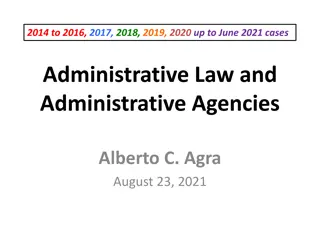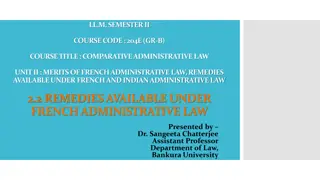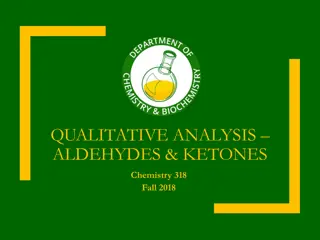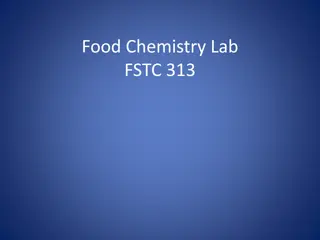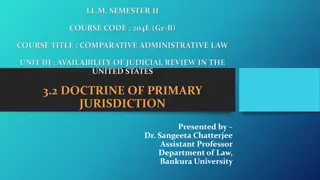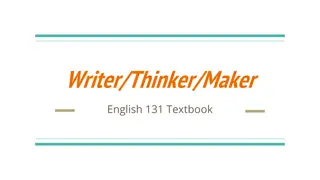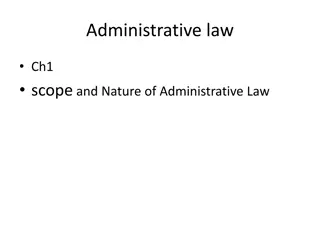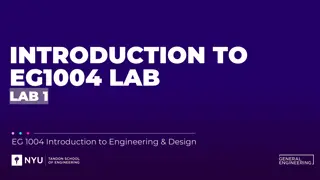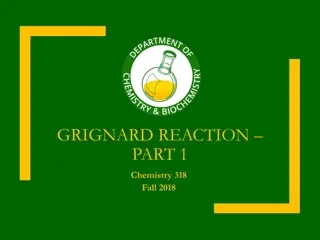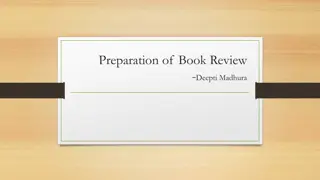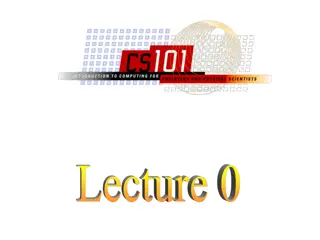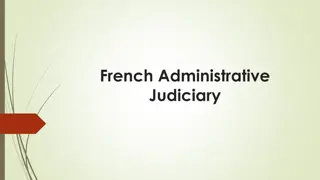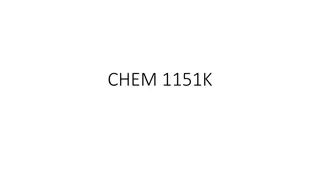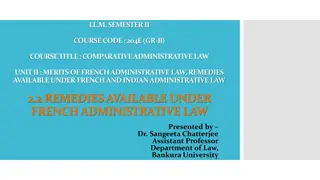Chemistry Lab Course: Administrative Issues, Course Overview, and Textbook Requirements
This comprehensive guide covers administrative issues for a chemistry lab course, reasons for taking chemistry labs, course overviews including experiments and analyses, and required textbooks for life science majors. It emphasizes the importance of punctuality, wait-list policies, and necessary texts for successful completion of the course.
Download Presentation

Please find below an Image/Link to download the presentation.
The content on the website is provided AS IS for your information and personal use only. It may not be sold, licensed, or shared on other websites without obtaining consent from the author.If you encounter any issues during the download, it is possible that the publisher has removed the file from their server.
You are allowed to download the files provided on this website for personal or commercial use, subject to the condition that they are used lawfully. All files are the property of their respective owners.
The content on the website is provided AS IS for your information and personal use only. It may not be sold, licensed, or shared on other websites without obtaining consent from the author.
E N D
Presentation Transcript
Lecture 1a Administrative Issues
Course Overview I Why do students take chemistry labs? Most lecture courses provide a theoretical background in general and in organic chemistry but usually do not consider much many of the practical aspects of an experiment. Conducting an experiment in lab is often times much more complicated than chemistry conducted on paper because many details have a significant impact on the overall outcome of the experiment. Performing an actual experiment in the lab is a learning experience on how to combine many theoretical and practical aspects together (i.e., theory of the reaction, Le Ch telier Principle, polarity, acidity, kinetics, etc.).
Course Overview II Titration of an Unknown Amino Acid Determination of Iron in Vitamin Extraction of Caffeine from Tea Titrimetric Analysis of Vitamin C Isolation of Chlorophyll and Carotenoid (Pigments from Spinach) using Column Chromatography Aldol condensation Oxidation of Borneol to Camphor Distillation and Gas Chromatography Molecular Modeling Infrared Spectroscopy 13C NMR and DEPT Spectroscopy
Administrative Issues Make sure that you arrive on time to your first in-lab meeting because if you are more than 15 minutes late, you will lose your spot in the course. Lame excuses do not count later on i.e., I did not think that the lab meets during week 1 or I did not find the lab ! Wait-listed students will be accommodated if spaces become available during the first meeting of the section only: priority will be given based on seniority. We are not able to accommodate extension students this quarter. If the student is added to the roster, the instructor will report the student to the department to been enrolled (usually at the end of the first week and not on the same day!).
Textbooks/Readers Required Texts Chemistry Experiments for Life Science Majors (2ndedition) by A.A. Russell, Burgess Publishing (from 14BL) Techniques in Organic Chemistry (4thedition) by Mohrig, Alberg, Hofmeister, Schatz and Hammond (from 14BL) Laboratory notebook with duplicate carbon copies (from 14BL, available from the Undergraduate Chemistry Fraternity - AXE - Young Hall 1275 and the student store) Recommended Texts 14 CL Practice Problems and Exam Collection (Spring 2016, 3rdedition, $20) by A. Bacher available from Course Reader Material (1081 Westwood Boulevard) Peter Atkins, Loretta Jones, Chemical Principles The Quest for Insight (5thedition) (or any other equivalent general chemistry text) W. H. Brown, Organic Chemistry (7thedition) (or any other similar text) Mohrig et al., Techniques in Organic Chemistry (online: $47.99 for a 180 day subscription via coursesmart), most students usually have a copy already if they were enrolled in Chem 14BL recently
Preparation for In-lab Meeting To complete the laboratory work on time the student must prepare for the period s assignment before his/her laboratory section meets. The course is impacted; there is neither make-up time in the course nor space for the student to work in other sections. Pre-lab: title, purpose, introduction, balanced chemical equations, detailed procedure, safety information of all chemicals used (review the MSDS for each compound used in the experiment), spectroscopic information (a Xerox copy is preferable) In preparation for the lab, the student should first study the pertinent sections in the text, review the lecture notes pertaining to the experiment, then view (and possibly review) the appropriate videotapes for any new techniques to be used in the experiment If the student still has questions relating to the experimental details, s/he should consult a teaching assistant or the course instructor to clarify the procedure. The handout will not be helpful if the student does not understand the material. Pre-labs are due at the beginning of the lab period. Late pre-lab work will count as ZERO. The student will not be allowed to perform an experiment without providing a pre-lab. The duplicate copy of the in-lab data is to be turned in to the T.A. at the end of the lab period.
Grades I Grading: (To receive a passing grade (C-), you must complete ALL the experiments and reports and receive at least 50 % of the points in the exams category.) Preparation for lab - Prelab assignments Performance in lab - Lab technique & Lab Maintenance Documentation of lab work - Lab reports Conceptual understanding of Lab - Midterm Conceptual understanding of Lab - Final 108 56 212 80 160 616 17.5 % 9.1 % 34.4 % 13.0 % 26.0 % 100 % TOTAL Bottom line: Both, the in-lab portion and the final exam, have to be passed to pass the course. In order to get a high grade in the course, the student has to perform very well in both portions, not just in one portion.
Grades II Chemistry 14CL is graded on a mastery basis. Letter grades are based on the course point total. (Please note these grades are assigned only at the end of the quarter when all items have been graded and the grades have been adjusted; the percentage on a portion of the course is not a meaningful measure of the student s total performance.) As a rule of thumb, the course grades are assigned as follows: 90 80 65 50 0 - - - - - 100 % = 89 % = 79 % = 64 % = 49 % = A B C D F
Instructor Office: Young Hall 3077E Office hours: M-F 10-11 am and M 4-5 pm in YH 3077 in YH 3077 or by appointment (please do not schedule an appointment before 8 am or after 4:30 pm, if you do make an appointment, make sure to show up on time!) Email: bacher@chem.ucla.edu Course website: www.chem.ucla.edu/~bacher (Please note that the instructor does not use CCLE website) Course discussion board: www.piazza.com/ucla/spring2016/chem14cl The course discussion board has to be used for general chemistry questions only. This means that you cannot post homework or online quiz questions!



